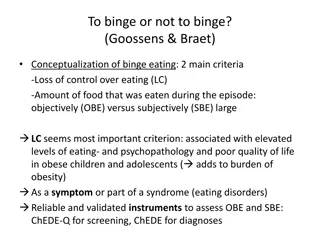Healthy Eating Guidelines for Common Health Conditions
Planning meals for individuals with cardiovascular disease, dental disease, diabetes, and obesity involves choosing the right foods from each food group, using healthy cooking methods, and avoiding excessive fats and sugars. For cardiovascular and dental health, emphasizing low-fat options, avoiding added sugars, and incorporating fruits and vegetables are essential. For diabetes management, focus on whole grains, lean proteins, and limiting sugar intake. Obesity management includes portion control, healthy snacking, and selecting low-fat alternatives. These dietary strategies aim to support overall health and reduce the risk of associated health conditions.
Download Presentation

Please find below an Image/Link to download the presentation.
The content on the website is provided AS IS for your information and personal use only. It may not be sold, licensed, or shared on other websites without obtaining consent from the author.If you encounter any issues during the download, it is possible that the publisher has removed the file from their server.
You are allowed to download the files provided on this website for personal or commercial use, subject to the condition that they are used lawfully. All files are the property of their respective owners.
The content on the website is provided AS IS for your information and personal use only. It may not be sold, licensed, or shared on other websites without obtaining consent from the author.
E N D
Presentation Transcript
Cardiovascular disease: The most common cause of death and disability in Ireland.
Planning meals for a person with coronary heart disease: Choose the right amounts from each shelf of the food pyramid. Use low-fat cooking methods and choose low-fat options. Use vegetable oils instead of butter. Measure oil with a spoon.
Planning meals for a person with coronary heart disease: Remove visible fat from meat. Use herbs and spices instead of salt. Use fruit- and vegetable-based sauces. Choose fish. Eat nuts and seeds to increase fibre content. Use salad dressings sparingly. Watch portion size.
Planning meals for a person with dental disease: Choose the right amounts from each shelf of the food pyramid. Drink water instead of sugary drinks. Drink fluoridated water. Avoid adding sugar.
Diabetes: The body cannot control the level of sugar in the blood.
Planning meals for a diabetic: Choose the right amounts from each shelf of the food pyramid. Use low-fat cooking methods and choose low-fat options. Remove visible fat from meat. Use herbs and spices instead of salt. Include fruit, vegetables and whole grains. Don t add sugar.
Obesity: Abnormal or excessive fat accumulation that presents a risk to health.
Planning meals for obesity: Choose the right amounts from each shelf of the food pyramid. Prepare healthy snacks using low-fat cooking methods and choose low-fat options. Measure oil with a spoon.
Planning meals for obesity: Remove visible fat from meat. Don t add sugar. Include fruit, vegetables and whole grains in the diet. Use salad dressings sparingly. Watch portion size. Drink eight glasses of water each day.
Osteoporosis: A disease where bones become very fragile and more likely to break.
Planning meals for a person with osteoporosis: Choose the right amounts from each shelf of the food pyramid. Include dairy and vitamin D. Include calcium from plants, such as tofu, almonds and sesame seeds. Include fortified foods. Use herbs and spices instead of salt. Avoid drinking tea and coffee with meals.
Illustrations: Shutterstock iStock Alamy























